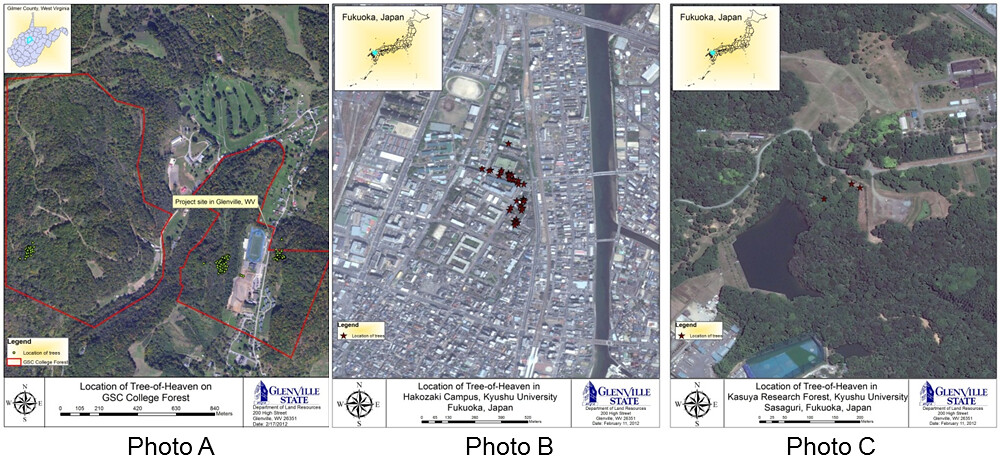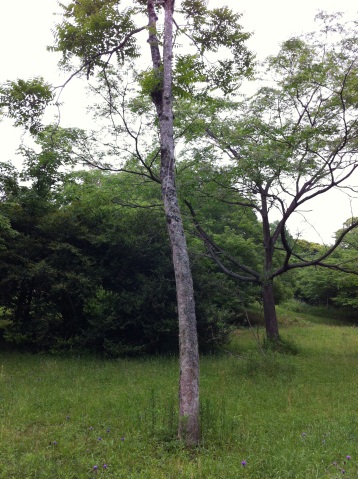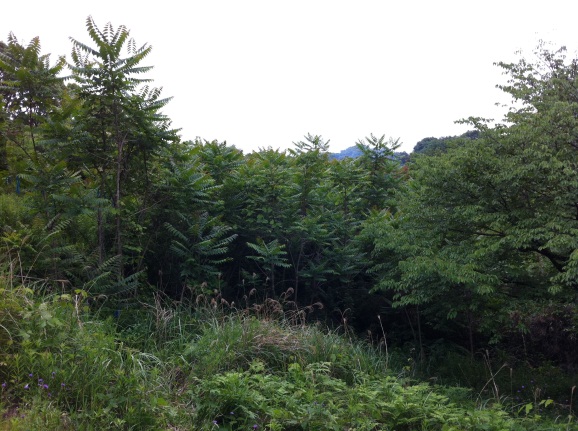This week, Dr. Rico Gazal continues his discussion of Tree-of-heaven and provides initial research results.
Tree-of-heaven (Ailanthus altissima) is spreading widely throughout West Virginia and threatening the native forest ecosystems in Appalachia. This invasive plant was introduced to the United States from China in the 1780s. The same exotic tree species was also introduced to Japan in 1860s but is not aggressive in this country. In Japan, particularly in the Kyushu Island, tree-of-heaven is rarely found in natural forest ecosystems but a few trees may be found growing in university campuses (i.e. Kyushu University), school premises and house backyards. Tree-of-heaven was initially introduced in the US and Japan as an ornamental plant cultivated in urban areas to combat air pollution. Similarities and differences in behavior and ecology of tree-of-heaven can be attributed to different climatic regions where they exist: cool temperate in West Virginia, USA and warm temperate in Fukuoka, Japan.

Maps showing the location of tree-of-heaven in Glenville, West Virginia and Fukuoka, Japan. The invasive plants in West Virginia are naturally growing in native forests (Photo A) while those in Fukuoka, tree-of-heaven were planted on campus of Kyushu University located in the center of Fukuoka city (Photo C) and others can be found on an experimental forest that was planted for demonstration purposes (Photo B). Although tree-of-heaven were artificially planted in Fukuoka, evidence of successful establishment with significant amount of natural regeneration (seedlings) indicates their potential to eventually encroach Japan’s native forests in the future.
Continuous encroachment of Ailanthus and its accompanied modification of the site conditions pose a great threat to the existence of native plants and to the overall productivity and stability of natural forests. The success of Ailanthus and the reduction in the occurrence of native species beneath them is most likely the result of its strong competitive abilities, particularly its allelopathy (the production of one or more biochemical that influence the growth, survival, and reproduction of other organisms), faster growth rate and abundant seed crops. It has been suggested that Ailanthus modify soil microbial communities and biogeochemical cycling in ways that can feedback to benefit them. Modification of soil chemical properties by Ailanthus trees and the release of toxins from stem, leaves, and roots are mechanisms by which they can maintain dominance in the stand. Success of Ailanthus in invading forest areas can be also attributed to its ability to exploit pulses of increased resource levels such as soil moisture and light. Low soil moisture and low light observed in pure stands of Ailanthus in Japan and West Virginia indicate its efficient light interception and water consumption capabilities. Hence, increased forest disturbances, accompanied by increased availability of sunlight, soil moisture, and nutrients could lead to more opportunities for Ailanthus to become established and invade natural forests.
Based on the preliminary analysis of our data, the leaf structure and physiological parameters measured in our study revealed unique differences in the key attributes of Ailanthus between West Virginia and Fukuoka, Japan that are associated with invasive success. Although leaf size was the same in both sites, specific leaf area, an indicator of photosynthetic capacity, was found larger in trees located in West Virginia compared to those in Fukuoka. Also, our analysis revealed that those trees in Fukuoka exhibited photoinhibition that can result to a decline in photosynthetic capacity due to high light intensity. Relative water content was lower in West Virginia than in Fukuoka that may indicate the ability of tree-of-heaven in West Virginia to sustain excessive water loss without desiccation. This translates to high photosynthesis that trees in West Virginia are able to sustain during the day. There were also leaf structural differences between the two sites with those in West Virginia exhibiting light-adapted leaf characteristics with shorter stomatal length and higher stomatal density than in Fukuoka. Stomata are microscopic pores on the leaf surface where carbon dioxide and water vapor exchange take place. The different physiological and morphological parameters indicate a more aggressive nature of tree-of-heaven in West Virginia compared to Fukuoka, Japan. Although Ailanthus spp. in Fukuoka may still be in its early stage of invasion, its successful establishment where it was originally planted and aggressive physiological characteristics showed its potential to continuously invade natural forest ecosystems of Japan. Ailanthus is rarely found in natural forest in Japan which could also be due to unique environmental factors in the warm temperate environment that control its spread such as presence of biological enemies and faster decomposition rate due to high moisture and temperature that may counteract the effect of its allelopathy.

Ailanthus seedlings planted on campus of Kyushu University, Japan

A mature Ailanthus tree and naturally growing seedlings on the campus of Kyushu University, Japan.

An Ailanthus tree that was artificially planted on a demonstration forest of Kyushu University. This experimental site is mowed on a regular basis as indicated by the absence of understory vegetation.

Natural regeneration of tree-of-heaven with plenty of light exposure on an experimental forest in Kyushu, Japan
Starting today, 1 August 2012, The GLOBE Program launches its Phenology and Climate Project! How could you connect Budburst, Green Up and/or Green Down to an invasive plant species investigation? We’d love to hear about it! Leave a comment or send us an email at science@globe.gov.
